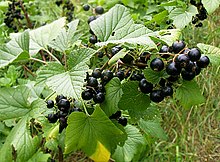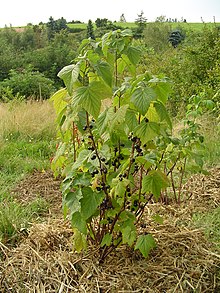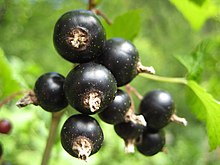
"Black currant" redirects here. For the Australian fruit, see Carissa spinarum.
| ||||||||||||||||||||||||||||||
Blackcurrant, with the scientific name Ribes nigrum, is a species of Ribes native to central and northern Europe, and northern Asia. It is widely cultivated commercially and domestically as a temperate fruit crop for its abundant berries. It is less well known in the United States where it has been subject to restrictions as a disease vector for most of the 20th century.
Description
Ribes nigrum, the blackcurrant, is a medium sized shrub, growing to 1.5 metres (4.9 ft) x 1.5 metres (4.9 ft). The leaves are alternate, simple, 3–5 cm long and broad, and palmate with five lobes, with a serrated margin. When not in fruit, all parts of the plant are strongly aromatic, with the familiar blackcurrant fragrance. Theflowers are 4–6 mm diameter, with five reddish-green to brownish petals; they are produced in racemes 5–10 cm long.
In midsummer the green fruit ripens to an edible berry up to 1 cm in diameter, very dark purple in colour, almost black, with a glossy skin and a persistent calyx at the apex, and containing several seeds dense in nutrients (notably Vitamin C). An established bush can produce up to 5 kilograms (11 pounds) of fruit.
Plants from Northern Asia are sometimes distinguished as a separate variety, Ribes nigrum var. sibiricum, or even as a distinct species Ribes cyathiforme.
[edit]Cultivars
There are many cultivars of blackcurrant, including:
|
|
|
|
|
The cultivars 'Ben Connan',[2] 'Ben Lomond',[3] and 'Ben Sarek'[4] have gained the Royal Horticultural Society's Award of Garden Merit.[5]
New varieties are being developed continually to improve frost tolerance, disease resistance, machine harvesting, fruit quality, nutritional content and fruit flavour.[6] Two new releases from a black currant breeding program in British Columbia, Canada — Blackcomb and Tahsis — were selected for their immunity to White Pine Blister Rust and frost tolerance.[7]
Varieties producing green fruit, less strongly flavoured and sweeter than typical blackcurrants, are cultivated in Finland, where they are called "greencurrants" (viherherukka).[8]
[edit]Cultivation
- Pre-plant preparation
It is important that there is complete weed eradication for one season before planting. The use of herbicides for broadleaf weeds and grass is not recommended.
Growers should assess general fertility of planting site (e.g. nutrients, pH) to ensure the site meets the recommended planting conditions as outlined in the corresponding growers' guide (www.berrycrops.net). Manage crop requirements with annual soil sample indicating raspberries as the crop being tested (nobody will know the requirements for Ribes); Amend pH to 6 - 6.5.
Access to adequate irrigation and drainage are very important to consider before planting.
- Pest and weed controls
See Berry Crops Currant and gooseberry pest control guide or extension agents for approved controls. [9]
Growers can use organic mulch (including sawdust and straw), heavy plastic with an organic mulch cover, or landscape fabric as means of suppressing weed growth.
- Pruning
Annual pruning of old wood and shoots that are less than ~45 degrees to the ground is critical to crop management and machine harvest. Often if pruning of leaning shoots is neglected, the weight of the fruit they bear will bring them to the ground where the fruit will rot or be damaged. Pruning can be done by hand or mechanically.
[edit]Diseases
Ribes plants are susceptible to an array of diseases, including white pine blister rust and mildew. There are, however, new varieties being developed, or have already been developed, to overcome some of these diseases. [10][11]
Reversion (mainly blackcurrants) causes a decline in yield, and is quite widespread in Europe (but rarely on other continents). It often goes unnoticed by private gardeners. It is not related to the recognised botanical process of reversion, but is a virus carried by the Blackcurrant gall mite Cecidophyopsis ribis. Symptoms include a modification of leaf shape in summer, and swollen buds ("Big bud") often carrying thousands of microscopic mites, appearing in winter.[12] While pest control has limited effectiveness, severely infected bushes should be destroyed. All new plants purchased should be certified as virus-free.[13]
Currant and gooseberry leaf spot (Drepanopeziza ribis) is another disease, but it is not usually a serious problem for most varieties developed through prominent breeding programs.
[edit]History
[edit]United Kingdom
| This section needs additional citations for verification. (July 2010) |
The blackcurrant has been in domestic cultivation in Europe for up to 500 years. Its medicinal properties have been noted in various herbals. DuringWorld War II, most fruits rich in vitamin C, such as oranges, became almost impossible to obtain in the United Kingdom. Since blackcurrant berries are a rich source of vitamin C and blackcurrant plants are suitable for growing in the UK climate, blackcurrant cultivation was encouraged by the British government. Soon, the yield of the nation's crop increased significantly. From 1942 on, almost the entire British blackcurrant crop was made into blackcurrant syrup (or cordial) and distributed to the nation's children free, giving rise to the lasting popularity of blackcurrant flavourings in Britain.
During the 20th century in Europe much hybridisation work has been carried out, in order to reduce the plant's susceptibility to disease and frost, also to increase yields. This effort centred especially on Russia, Sweden and Scotland, where the popular series of "Ben" cultivars was developed by the Scottish Crop Research Institute. Latterly, New Zealand has become an important centre for research and development, as its temperate climate is beneficial to cultivation.[14]
[edit]United States
Blackcurrants were once popular in the United States as well, but became rare in the 20th century after currant farming was banned in the early 1900s, when blackcurrants, as a vector of white pine blister rust, were considered a threat to the U.S. logging industry.[15]
The federal ban on growing currants was shifted to jurisdiction of individual states in 1966, and was lifted in New York State in 2003 through the efforts of horticulturist Greg Quinn. As a result, currant growing is making a comeback in New York, Vermont, Connecticut and Oregon.[16][17] However, several statewide bans still exist including Maine,[18] New Hampshire[19] and Massachusetts.[20]
Since the American federal ban curtailed currant production nationally for nearly a century, the fruit remains largely unknown in the United States, and has yet to regain its previous popularity to levels enjoyed in Europe or New Zealand. Owing to its unique flavour and richness in polyphenols, dietary fibre and essential nutrients, awareness and popularity of blackcurrant is once again growing, with a number of consumer products entering the U.S. market.
[edit]Nutrients and phytochemicals
| Nutritional value per 100 g (3.5 oz) | |
|---|---|
| Energy | 264 kJ (63 kcal) |
| Carbohydrates | 15.4 g |
| Fat | 0.4 g |
| Protein | 1.4 g |
| Thiamine (vit. B1) | 0.05 mg (4%) |
| Riboflavin (vit. B2) | 0.05 mg (4%) |
| Niacin (vit. B3) | 0.3 mg (2%) |
| Pantothenic acid (B5) | 0.398 mg (8%) |
| Vitamin B6 | 0.066 mg (5%) |
| Vitamin C | 181 mg (218%) |
| Vitamin E | 1 mg (7%) |
| Calcium | 55 mg (6%) |
| Iron | 1.54 mg (12%) |
| Magnesium | 24 mg (7%) |
| Manganese | 0.256 mg (12%) |
| Phosphorus | 59 mg (8%) |
| Potassium | 322 mg (7%) |
| Sodium | 2 mg (0%) |
| Zinc | 0.27 mg (3%) |
| Link to USDA Database entry Percentages are relative to US recommendations for adults. Source: USDA Nutrient Database | |
The fruit has extraordinarily high vitamin C content (302% of the Daily Value per 100 g, table), good levels of potassium, phosphorus, iron and vitamin B5, and a broad range of other essential nutrients (nutrient table, right).
Other phytochemicals in the fruit (polyphenols/anthocyanins) have been demonstrated in laboratory experiments with potential to inhibit inflammationmechanisms suspected to be at the origin of heart disease, cancer, microbial infections or neurological disorders like Alzheimer's disease.[21][22]Major anthocyanins in blackcurrant pomace are delphinidin-3-O-glucoside, delphinidin-3-O-rutinoside, cyanidin-3-O-glucoside, and cyanidin-3-O-rutinoside[23] which are retained in the juice concentrate among other yet unidentified polyphenols.[24][25]
Blackcurrant seed oil is also rich in many nutrients, especially vitamin E and several unsaturated fatty acids including alpha-linolenic acid andgamma-linolenic acid.[26] In a human pilot study, ingestion of blackcurrant seed oil by mothers reduced atopic dermatitis in their breast-fed newborns who were supplemented with the oil over two years.[27]
[edit]Culinary uses
It was once thought that currants needed to be "topped and tailed" (the flower remnants and the stalks removed) before cooking.[citation needed] This is not the case, though, as these parts are easily assimilated during the cooking process. If one prefers, the whole blackcurrant stem and fruit can be frozen, then shaken vigorously. The tops and tails will break off, and the fruit can then be easily separated.
The fruit can be eaten raw, but its strong, tart flavour requires sweetening to be palatable. It is usually cooked with sugar to produce a puree, which can then be sieved in muslin to make juice. The puree can be used in jam, jelly, cheesecake, yogurt, ice cream, sorbet, and many other dishes both sweet and savoury. The exceptionally strong flavour can be moderated by combining it with other fruits, such as raspberries and strawberries in summer pudding; or apples in crumbles and pies.[28] They are a common ingredient ofRødgrød, a popular kissel-like dessert in North German and Danish cuisines.
Besides being juiced and used in jellies, syrups, and cordials, blackcurrants are also used in cooking because their astringency creates flavour in many sauces, meat dishes, and desserts.
In the United Kingdom, Europe and Commonwealth countries, blackcurrant is included in many fruit-flavoured sweet selections. In the United States,grape flavour is often used in brands of candy where blackcurrant would appear in Europe.
Japan imports $3.6 million of New Zealand blackcurrants for uses as dietary supplements, snacks, functional food products and as quick-frozen (IQF) produce for culinary production as jams,jellies or preserves.[29]
[edit]Drinks
The juice forms the basis for various popular cordials and alcoholic beverages. Blackcurrant liqueur mixed with white wine is called Kir or Kir Royale when mixed with champagne. Macerated blackcurrants are also the primary ingredient in the apéritif crème de cassis.
In the UK, blackcurrant cordial is often mixed with cider (hard cider) to make a drink called "Cider and Black" or if made with the popular British cider Strongbow a "Bow and Black". If made with any common British lager beer, it is known as a "Lager and Black". The addition of blackcurrant to a mix of cider and lager results in "Diesel" or "Snakebite and Black" available at pubs. Adding a small amount of blackcurrant juice to Guinness is preferred by some to heighten the taste of the popular stout.
In Russia, blackcurrant leaves may be used for flavouring tea or preserves, such as salted cucumbers, and berries for home winemaking. Sweetened vodka may also be infused with blackcurrant leaves or berries, making a deep yellowish-green beverage with a sharp flavour and astringent taste.
Ribena, a non-carbonated soft drink flavored with blackcurrants, takes its name from Ribes.




No comments:
Post a Comment